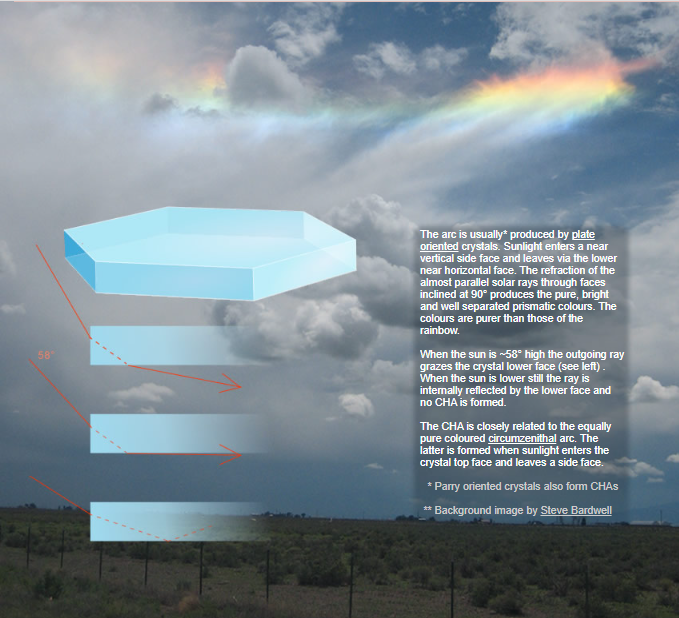Circumhorizon arc
Circumhorizon Arc: A Phenomenon of Pure, Bright, and Well-Separated Colors
The atmospheric optics phenomenon known as the Circumhorizon Arc (CHA) is a captivating display of pure, bright, and well-separated prismatic colors. It occurs when sunlight enters a near vertical side face of plate-oriented crystals and exits through the lower near horizontal face. This unique refraction of almost parallel solar rays through faces inclined at 90 degrees creates the stunning array of colors that are even purer than those seen in a rainbow.
The formation of the CHA is dependent on the position of the sun in the sky. When the sun is approximately 58 degrees high, the outgoing ray grazes the lower face of the crystal, resulting in the formation of the CHA. However, as the sun lowers further, the ray internally reflects off the lower face, preventing the formation of the CHA.
Interestingly, the CHA is closely related to another equally pure-colored atmospheric optics phenomenon called the circumzenithal arc (CZA). While the CHA is formed when sunlight enters the crystal's side face and exits through the lower face, the CZA is formed when sunlight enters through the crystal's top face and exits through a side face. Both phenomena share similar characteristics in terms of their vibrant colors and pristine separation.
It's important to note that not only plate-oriented crystals can produce CHAs; Parry-oriented crystals can also contribute to their formation. The orientation of these crystals plays a significant role in determining the specific optical effects observed in the atmosphere.
The visual beauty of the CHA is often enhanced by its association with other atmospheric optics phenomena, such as halos, rainbows, and other arcs. These natural wonders can create a mesmerizing tapestry in the sky, captivating observers and leaving them in awe of nature's artistic display.
Photographers and sky enthusiasts often find themselves captivated by the CHA's striking appearance. Capturing the CHA in all its glory requires careful observation of the sun's position, as well as an understanding of the atmospheric conditions that favor its formation. Patience and persistence are key, as the CHA is a relatively rare phenomenon that requires specific conditions to manifest.
In conclusion, the Circumhorizon Arc is a remarkable atmospheric optics phenomenon that showcases the purest, brightest, and most well-separated prismatic colors in the sky. Its formation is dependent on the orientation of plate or Parry-oriented crystals and the position of the sun in the sky. When observed alongside other atmospheric optics phenomena, the CHA creates a stunning visual spectacle that never fails to inspire awe and wonder. So, keep your eyes on the sky, and you may be lucky enough to witness this captivating display of nature's artistic prowess.

The arc is usually produced by plate oriented crystals. Sunlight enters a near vertical side face and leaves via the lower near horizontal face. The refraction of the almost parallel solar rays through faces inclined at 90 degree produced the pure, bright and well separated prismatic colours. The colours are purer than those of the rainbow.
When the sun is approximately 58 degree high the outgoing ray grazes the crystal lower face (see left). When the sun us lower still the ray is internally by the lower face and no CHA is formed.
The CHA is closely related to the equally pure coloured circumzenithal arc. The latter is formed when sunlight enters the crystal top face and leaves a side face.
. Parry oriented crystals also form CHAs
.. Background image by Steve Bardwell
Note: this article has been automatically converted from the old site and may not appear as intended. You can find the original article here.
Reference Atmospheric Optics
If you use any of the definitions, information, or data presented on Atmospheric Optics, please copy the link or reference below to properly credit us as the reference source. Thank you!
-
<a href="https://atoptics.co.uk/blog/circumhorizon-arc-2/">Circumhorizon arc</a>
-
"Circumhorizon arc". Atmospheric Optics. Accessed on April 16, 2024. https://atoptics.co.uk/blog/circumhorizon-arc-2/.
-
"Circumhorizon arc". Atmospheric Optics, https://atoptics.co.uk/blog/circumhorizon-arc-2/. Accessed 16 April, 2024
-
Circumhorizon arc. Atmospheric Optics. Retrieved from https://atoptics.co.uk/blog/circumhorizon-arc-2/.